Welcome to our comprehensive guide on Cryptocoryne Wendtii Tropica, an incredibly versatile and captivating aquatic plant.
Whether you’re a beginner aquarist or a seasoned enthusiast, discovering the intricate world of Cryptocoryne Wendtii Tropica will open up new possibilities for your aquarium.
In this guide, we will delve into the various aspects of this fascinating plant, from its origins and anatomy to cultivation techniques and design ideas. Let us demystify the secrets of Cryptocoryne Wendtii and help you create a thriving aquatic environment.
But first, what exactly is Cryptocoryne Wendtii? Cryptocoryne Wendtii is a popular aquatic plant species that belongs to the Araceae family. With its vibrant foliage and relatively easy care requirements, it has become a staple in many planted aquariums around the world.
Its origins can be traced back to the regions of Sri Lanka and the Indian subcontinent, where it thrives in the lush, tropical environment.
This guide will discuss the geographical distribution and environmental conditions that Cryptocoryne Wendtii Tropica prefers. We will explore its unique leaf structure, rhizome, and root system, as well as its inflorescence and reproductive features.
Additionally, we will provide insights into the cultivation techniques, including planting, lighting, and nutrient requirements. We will also address common diseases and pests that may affect Cryptocoryne Wendtii and offer preventative measures and treatments.

Key Takeaway
- Cryptocoryne Wendtii is a versatile and captivating aquatic plant from the Araceae family.
- It originates from Sri Lanka and the Indian subcontinent, thriving in tropical environments.
- Understanding its geographical distribution and environmental conditions is crucial for successful cultivation.
- Its unique leaf structure, rhizome, root system, inflorescence, and reproductive features contribute to its overall beauty.
- Proper planting techniques, lighting, and nutrient requirements are key to maintaining healthy growth.
Quick Stats
| Attribute | Details |
| Family Name | Araceae |
| Origin | Cultivar |
| Height | 10-20 cm (4-8 inches) |
| pH Range | 6.0 – 8.0 |
| CO2 Requirement | Low to Moderate |
| Growth Rate | Moderate |
| Care Level | Moderate |
| Color Form | Bronze-green, with wavy margins |
| Water Conditions | 22-28°C (72-82°F), adaptable to a wide range of hardness |
| Max Size | Leaves can grow up to 20 cm (8 inches) long |
| Lighting | Low to Moderate |
| Supplements | Root tabs and liquid CO2, if necessary; benefits from iron supplementation |
| Placement | Mid-ground |
| Propagation | By runners |
What Is Cryptocoryne Wendtii?
Cryptocoryne Wendtii is a popular aquatic plant in the Araceae family. It is native to Southeast Asia and is widely known for its beautiful and vibrant foliage. Aquarium enthusiasts and aquascapers covet this species due to its versatility and ability to thrive in various environments.
Cryptocoryne Wendtii is a must-have plant for any aquatic plant enthusiast looking to add color and texture to their aquarium.
Natural And Origin
- Native Habitat: Cryptocoryne wendtii is indigenous to Sri Lanka, where it grows abundantly in various aquatic habitats. It is commonly found along the banks of streams, rivers, and marshy areas with slow-moving or stagnant water. In its natural environment, Cryptocoryne wendtii often grows submerged or partially submerged, forming dense clusters of leaves.
- Origin: The species was first described scientifically by Dutch botanist C.A.J.A. O. Blume in 1826. Its specific epithet, “wendtii,” honors the German-Dutch plant collector, H.A. Wendt, who collected botanical specimens in Sri Lanka during the 19th century. Since its discovery, Cryptocoryne wendtii has become widely cultivated and is now found in aquariums and aquatic gardens around the world.
- Adaptability: Cryptocoryne wendtii has adapted to a range of environmental conditions in its native habitat, including varying water flow, light levels, and substrate types. This adaptability has contributed to its popularity as an aquarium plant, as it can thrive in diverse tank setups and water parameters. Additionally, its attractive foliage and ease of care make it a favored choice among aquarists of all skill levels.
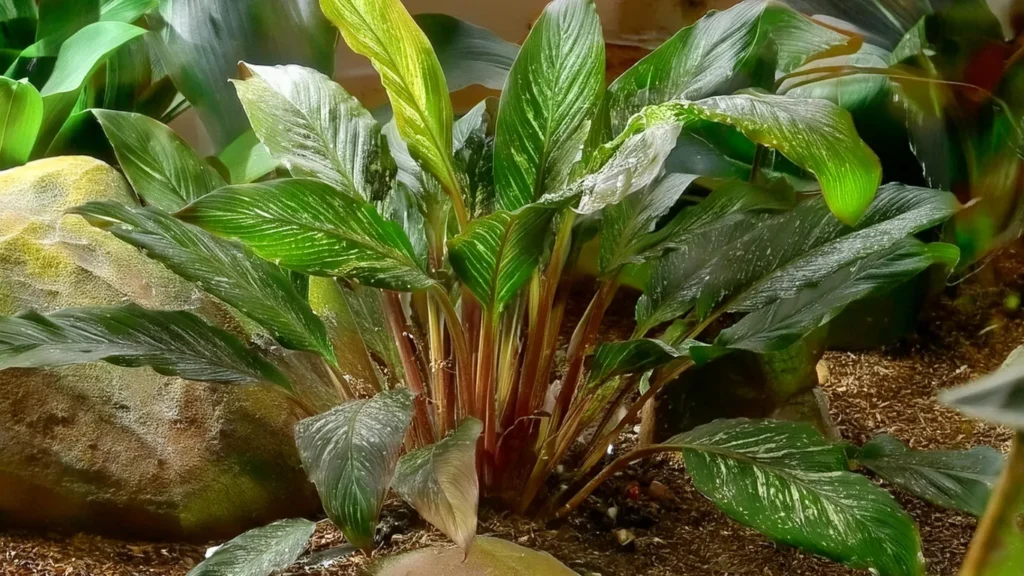
Physical Characteristics Of Cryptocoryne Wendtii
- Leaves: The leaves of Cryptocoryne wendtii tropica are typically broad, lanceolate, and elongated, with a pointed tip. They grow in a rosette pattern from a central rhizome and can vary in color from green to brown or reddish-brown, depending on factors such as light intensity and water parameters. The leaf margins may be smooth or slightly undulated, adding texture to the plant’s appearance.
- Rhizome: Like other Cryptocoryne species, Cryptocoryne wendtii features a creeping rhizome from which the leaves emerge. The rhizome is usually brown or tan in color and produces adventitious roots that anchor the plant to the substrate. It grows horizontally along the substrate surface and may occasionally send out runners to propagate new plants.
- Size: Cryptocoryne wendtii exhibits moderate growth and typically reaches heights of 10 to 20 centimeters (4 to 8 inches) under aquarium conditions. However, in optimal conditions with ample nutrients and lighting, it may grow taller, and its leaves may become more elongated. The plant forms dense clusters of leaves, creating a lush and visually appealing display in the aquarium.
Lighting And Nutrient Requirements
- Cryptocoryne Wendtii requires moderate to high lighting levels for healthy growth. Provide a suitable lighting system with a color temperature range of 5000-7000K to mimic natural sunlight.
- Consider using LED lights, as they are energy-efficient and provide a balanced spectrum. Regarding nutrients, Cryptocoryne Wendtii benefits from a nutrient-rich substrate and regular fertilization.
- Use a substrate specifically formulated for aquarium plants and supplement with liquid fertilizers as needed to ensure optimal growth and vibrant foliage.
RELATED: Grow Cryptocoryne Lutea For Vibrant Aquariums With This Simple Guide
Temperature Parameters For Optimal Growth
- Cryptocoryne wendtii tropica thrives in a tropical environment, preferring relatively warm water temperatures for optimal growth. The recommended temperature range for this species is typically between 22°C to 28°C (72°F to 82°F).
- Maintaining the aquarium temperature within this range helps promote healthy growth and encourages the plant to exhibit its full potential. However, Cryptocoryne wendtii can tolerate slight fluctuations in temperature, but sudden or extreme changes should be avoided as they can stress the plant and negatively impact its health.
Water Parameters And Substrate Preferences
- Cryptocoryne Wendtii tropica prefers water that is slightly acidic to neutral, with a hardness level of 3-8 dKH. It can tolerate low light conditions, although it will exhibit more vibrant colors and faster growth rates under moderate to high lighting. Adequate lighting is crucial for photosynthesis, ensuring the plant’s overall health and development.
- In terms of substrate, Cryptocoryne Wendtii thrives in nutrient-rich substrates that contain materials such as clay, gravel, or sand. The plant forms a strong root system that anchors itself in the substrate, allowing it to absorb essential nutrients for growth.
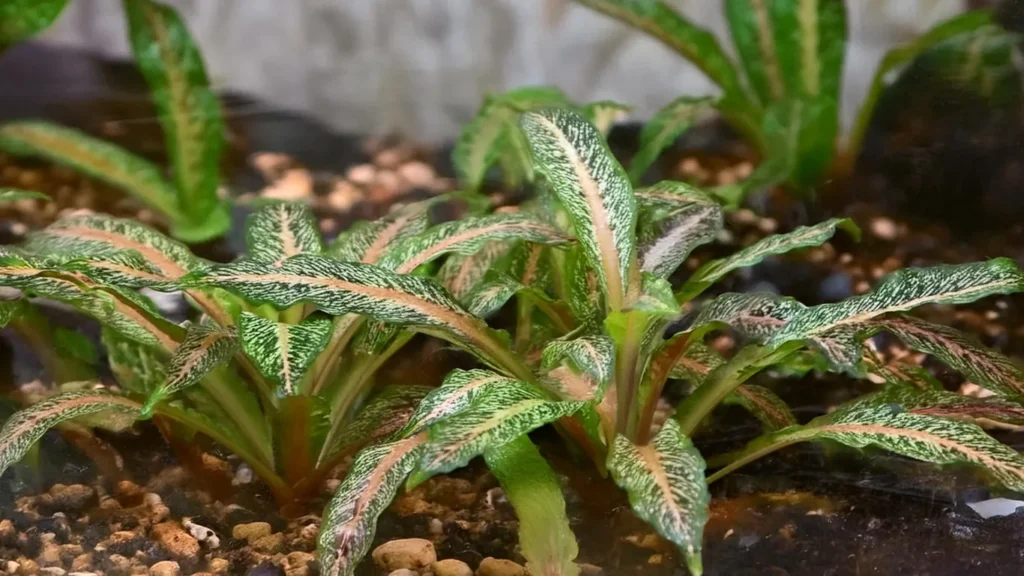
Substrate Requirements
- Fine-Grained Substrate: This plant prefers a substrate with a fine-grained texture, such as aquarium sand or fine gravel. The substrate should be well-rounded and not sharp, as sharp substrate materials can damage the delicate roots of Cryptocoryne wendtii.
- Nutrient-Rich Substrate: Cryptocoryne wendtii benefits from a nutrient-rich substrate that provides essential minerals and trace elements for healthy growth. Consider using specialized aquarium plant substrates or adding root tabs to the substrate to ensure an adequate supply of nutrients.
- Depth: The substrate depth should be sufficient to allow the roots of Cryptocoryne wendtii to anchor securely. Aim for a substrate depth of at least 5 to 8 centimeters (2 to 3 inches) to provide ample room for root development.
- Stability: It’s important to maintain substrate stability to prevent disturbance to the plant’s roots. Avoid excessive water flow or substrate vacuuming around Cryptocoryne wendtii to minimize disruption to its root system.
RELATED: The Aquatic Wonder Bacopa Australis To Transform Your Aquascape
Placement Options
- Foreground: Planting Cryptocoryne wendtii in the foreground of the aquarium can create a visually appealing transition between the substrate and midground or background plants. Arrange it in clusters or small groups along the front glass of the tank to frame the scenery and add depth to the aquascape.
- Midground: Cryptocoryne wendtii can also be placed in the midground area of the aquarium, where it serves as a focal point or fills in gaps between other plants. Its moderate height and lush foliage make it suitable for creating a dense, bushy effect in this area.
- Background: In larger aquariums, Cryptocoryne wendtii can be used as a background plant to add height and texture to the rear of the tank. Plant it behind other foreground and midground plants to create layers of greenery and provide a natural backdrop for the aquascape.
- Hardscape Integration: Cryptocoryne wendtii can be strategically placed around hardscape elements such as driftwood, rocks, or aquatic ornaments to soften their appearance and create a more naturalistic environment. Ensure that the plant’s roots have sufficient substrate coverage and avoid blocking its access to light.
Recommended Tank Size
- For smaller aquarium setups, such as nano tanks or those under 20 gallons (75 liters), Cryptocoryne wendtii can be an excellent choice due to its moderate size and growth rate. A tank size of 5 to 10 gallons (19 to 38 liters) can accommodate this plant well, especially when combined with other compatible species.
- In medium-sized aquariums ranging from 20 to 50 gallons (75 to 190 liters), Cryptocoryne wendtii can be showcased as a prominent foreground, midground, or background plant, depending on the aquascape design. This size range provides ample space for the plant to spread and develop dense clusters of leaves.
- Larger tanks exceeding 50 gallons (190 liters) offer even more flexibility in incorporating Cryptocoryne wendtii into the aquascape. With proper placement and spacing, this plant can contribute to creating lush, naturalistic scenes in spacious aquarium environments.

Suitable Tank Mates
- Peaceful Community Fish: Many peaceful community fish species make excellent tank mates for Cryptocoryne wendtii. Examples include tetras (such as neon tetras and cardinal tetras), rasboras, danios, guppies, mollies, platies, and small to medium-sized catfish species like Corydoras.
- Shrimp and Snails: Neocaridina and Caridina shrimp species, such as Cherry Shrimp and Amano Shrimp, as well as various snail species like Nerite Snails and Malaysian Trumpet Snails, can safely inhabit aquariums with Cryptocoryne wendtii. They help maintain the tank’s cleanliness by consuming algae and detritus.
- Dwarf Cichlids: Some dwarf cichlid species, such as Apistogramma and German Blue Rams, can coexist peacefully with Cryptocoryne wendtii, provided the tank is spacious enough and furnished with ample hiding spots and territories for each fish.
- Bottom-Dwelling Fish: Bottom-dwelling fish like Otocinclus Catfish and small species of plecos (such as Bristlenose Plecos) can complement Cryptocoryne wendtii by foraging for algae and detritus on the substrate without disturbing the plant’s roots.
- Non-Aggressive Invertebrates: In addition to shrimp and snails, other non-aggressive invertebrates like freshwater clams and small crayfish species (such as Dwarf Mexican Crayfish) can be suitable tank mates for Cryptocoryne wendtii in appropriately sized aquariums.
Nutrition Needs
Cryptocoryne wendtii requires a balanced supply of both macro and micronutrients to support its growth and overall health in the aquarium. Here’s a breakdown of the essential nutrients:
Macro Nutrients
- Nitrogen (N): Nitrogen is a vital component of chlorophyll, which is essential for photosynthesis. It’s obtained primarily from nitrates (NO3-) and ammonium (NH4+). Cryptocoryne wendtii absorbs nitrogen through its roots and leaves to support protein synthesis and overall growth.
- Phosphorus (P): Phosphorus is crucial for energy transfer within the plant and is a component of ATP (adenosine triphosphate), which is essential for cellular processes like photosynthesis and respiration. It’s typically obtained from phosphates (PO4^3-), which are absorbed by the plant’s roots.
- Potassium (K): Potassium plays a vital role in various physiological processes, including enzyme activation, osmoregulation, and water uptake. It also helps regulate stomatal opening and closing, which affects gas exchange and water loss. Potassium is absorbed as K+ ions from the water column and substrate.
Micro Nutrients
- Iron (Fe): Iron is essential for chlorophyll synthesis and is involved in photosynthesis and respiration. It also plays a role in nitrogen fixation and enzyme activation. Iron deficiency can lead to chlorosis (yellowing of leaves) in Cryptocoryne wendtii. Chelated iron supplements are commonly used to provide iron to aquarium plants.
- Magnesium (Mg): Magnesium is a component of chlorophyll and is involved in photosynthesis. It also activates enzymes and plays a role in nucleic acid and protein synthesis. Magnesium is typically available in the aquarium water and is absorbed by the plant’s roots.
- Calcium (Ca): Calcium is important for cell wall structure and integrity, as well as enzyme activation and signaling. It’s obtained from calcium ions (Ca2+) present in the water column and substrate.
- Manganese (Mn): Manganese is involved in photosynthesis, respiration, and enzyme activation. It’s absorbed as Mn2+ ions from the water column and substrate.
- Zinc (Zn): Zinc is a cofactor for many enzymes and is involved in various metabolic processes, including protein synthesis and hormone regulation. It’s typically absorbed as Zn2+ ions from the water column and substrate.
- Copper (Cu): Copper is involved in enzyme activation and electron transport. It’s absorbed as Cu2+ ions from the water column and substrate.
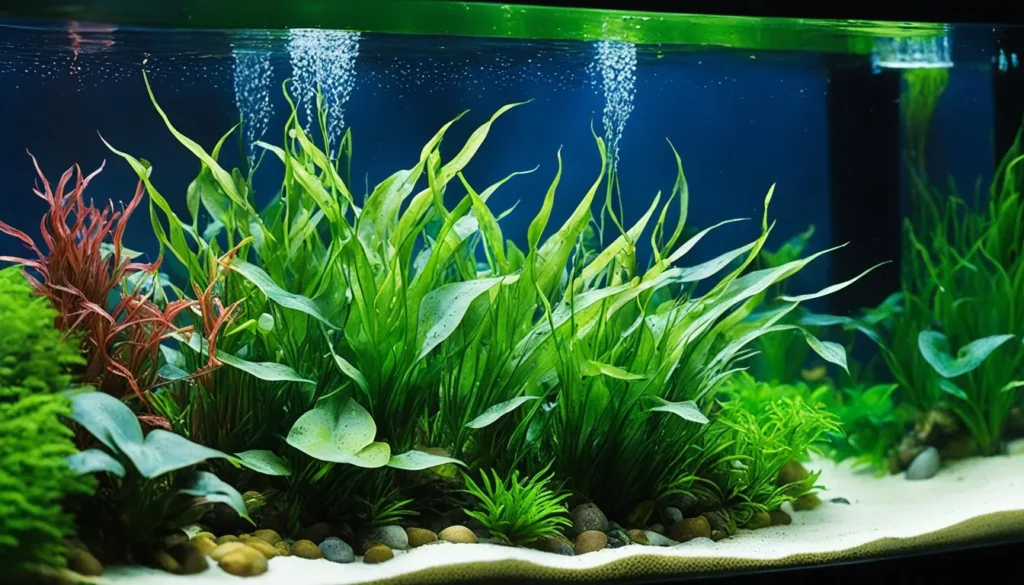
Cultivation Of The Plant
Cultivating Cryptocoryne wendtii involves several steps to prepare for growth, plant the specimens, and provide initial care. Here’s a guide to each stage:
Preparation For Growth
- Choose a suitable location in your aquarium for planting Cryptocoryne wendtii. Consider factors such as lighting, water flow, and the overall aquascape design.
- Ensure that the substrate is well-prepared. Cryptocoryne wendtii prefers nutrient-rich substrates such as aquarium soil or gravel supplemented with root tabs. The substrate should be deep enough to allow the plant’s roots to anchor securely.
- Adjust water parameters to match the plant’s requirements. Cryptocoryne wendtii thrives in slightly acidic to neutral pH (6.0-7.5) and soft to moderately hard water. Maintain stable water parameters to prevent stress to the plants.
- Provide appropriate lighting. Cryptocoryne wendtii can adapt to a range of light intensities, but moderate to low lighting is generally recommended to prevent algae growth and ensure healthy growth.
Planting
- Carefully remove Cryptocoryne wendtii tropica specimens from their pots or containers, taking care not to damage the roots or rhizomes.
- Use a pair of aquascaping tweezers to plant the specimens into the substrate. Plant them at a suitable distance apart to allow for future growth and expansion.
- Ensure that the roots are fully buried in the substrate while the rhizome (horizontal stem) remains above the substrate surface. Burying the rhizome can lead to rot and hinder the plant’s growth.
- Gently press down on the substrate around the base of each plant to secure them in place.
Initial Care
- After planting, fill the aquarium with water slowly to avoid disturbing the substrate and plants. Ensure that the water level covers the planted Cryptocoryne wendtii specimens.
- Monitor the plants closely in the following days and weeks. Cryptocoryne wendtii may experience some initial melting of older leaves as they acclimate to their new environment. This is normal and should not be a cause for concern.
- Maintain consistent water parameters, including temperature, pH, and hardness, to support the plants’ growth and prevent stress.
- Consider supplementing with liquid fertilizers or root tabs to provide essential nutrients for Cryptocoryne wendtii. Regular dosing of fertilizers can promote healthy growth and vibrant foliage.
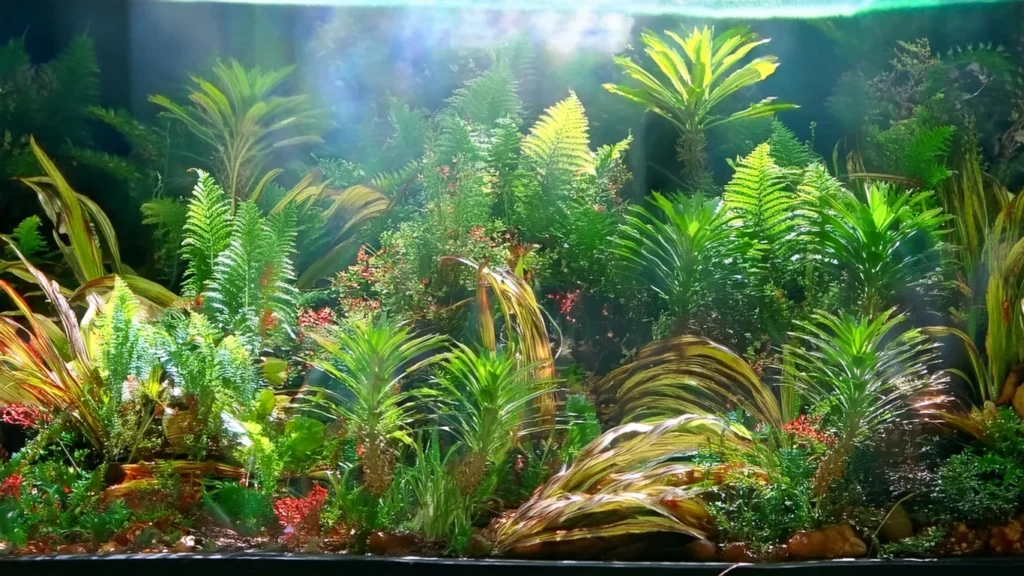
Plant Propagation Tips
- When dividing Cryptocoryne wendtii, ensure each section has both roots and a portion of the rhizome.
- Be patient with newly propagated plants as they may experience some initial melting of older leaves.
- Monitor water parameters closely after propagation to ensure stable conditions for healthy growth.
- Consider using root tabs or liquid fertilizers to provide essential nutrients to newly propagated plants.
- Propagating Cryptocoryne wendtii emersed can be an alternative method, especially for creating new plants from rhizome cuttings.
Benefits Of Cryptocoryne Wendtii
- Water Filtration: Cryptocoryne wendtii helps to improve water quality by absorbing excess nutrients, such as nitrates and phosphates, which can reduce algae growth and promote a healthier aquatic environment.
- Oxygenation: Like all aquatic plants, Cryptocoryne wendtii contributes to oxygenating the water through photosynthesis, providing a more oxygen-rich environment for fish and other aquatic inhabitants.
- Natural Habitat: Cryptocoryne wendtii mimics the natural habitat of many freshwater fish species, providing shelter, breeding sites, and a sense of security for them.
- Aesthetic Appeal: With its vibrant green foliage and varied leaf shapes, Cryptocoryne wendtii adds visual interest to an aquarium, enhancing its overall beauty and creating a natural-looking underwater landscape.
- Easy Care: Cryptocoryne wendtii is relatively easy to care for, making it suitable for beginners and experienced aquarists alike. It can tolerate a range of water conditions and requires minimal maintenance once established.
- Propagation: Cryptocoryne wendtii readily reproduces through division, allowing aquarists to propagate and share the plant with others. This makes it a cost-effective option for aquascaping and filling out a planted tank.
Identifying Common Health Issues
It is important to know the common health issues that Cryptocoryne Wendtii Tropica may face. By understanding the signs and symptoms, aquarists can take timely action to address these problems. Common health issues include:
- Leaf Melting and Yellowing: This may indicate nutrient deficiencies or poor water quality.
- Black Spots on Leaves: This can signify a bacterial or fungal infection.
- Stunted Growth: It could be caused by insufficient light or inadequate nutrient uptake.
- Root Rot: This can occur due to overwatering or poor substrate conditions.
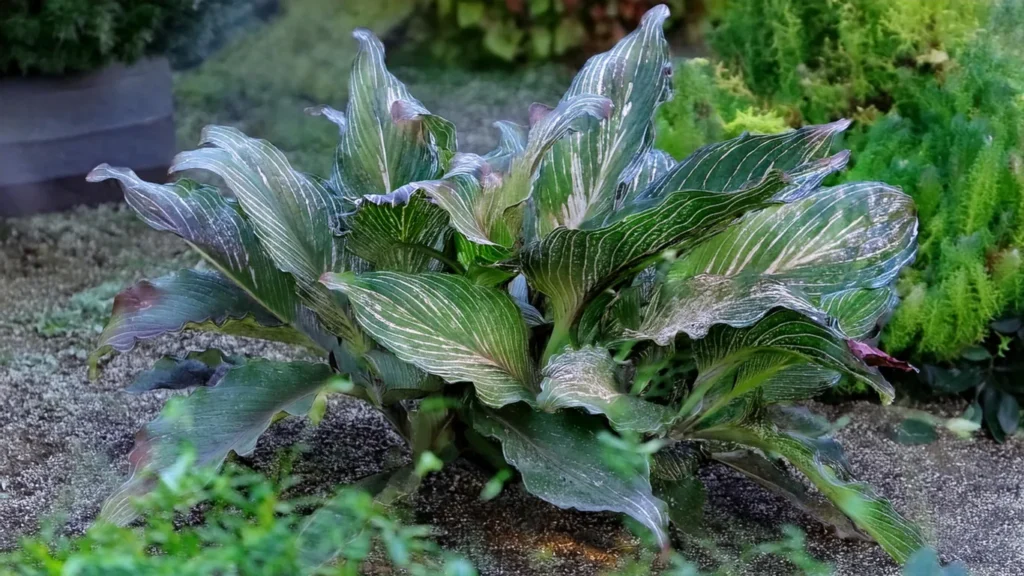
Conclusion
Throughout this comprehensive guide, we have delved into the fascinating world of Cryptocoryne Wendtii Tropica, providing you with a wealth of knowledge to understand and cultivate this remarkable plant.
From its geographical distribution and environmental preferences to its unique anatomy and morphology, we have explored every aspect of Cryptocoryne Wendtii.
By understanding the planting techniques, lighting and nutrient requirements, and maintenance pruning and propagation methods, you now have the tools to cultivate Cryptocoryne Wendtii successfully in your aquarium.
The various common varieties of Cryptocoryne Wendtii have also been highlighted, giving you a wide range of options to suit your aquascape.
Frequently Asked Question
What Distinguishes Cryptocoryne Wendtii From Other Aquatic Plants In A Planted Aquarium?
Cryptocoryne Wendtii is celebrated for its versatility and aesthetic appeal, featuring a range of colors from green to brown and even red, depending on the variety and growing conditions.
Its ability to thrive under a wide range of lighting conditions and its moderate growth rate and ease of care make it a favorite among novice and experienced aquarists. The textured, ruffled leaves add depth and contrast to aquascapes, making it a dynamic choice for foreground or midground placements.
How Do I Ensure Optimal Growth For Cryptocoryne Wendtii In My Aquarium?
To promote healthy growth, Cryptocoryne Wendtii Tropica requires a nutrient-rich substrate and consistent water parameters. Although it can adapt to low-light conditions, moderate to high lighting will enhance its coloration and growth rate.
It benefits from the addition of CO2 but can grow well without it. Regular dosing of liquid fertilizers, especially those rich in iron and potassium, will support its lush development. Avoid drastic changes in water parameters to prevent stress-induced melting.
Can Cryptocoryne Wendtii Be Used In A Low-Tech Aquarium Setup?
Cryptocoryne Wendtii Tropica is well-suited for low-tech setups due to its low to moderate light requirements and resilience. Its ability to adapt to various water conditions without the need for CO2 injection makes it a low-maintenance option for aquarists who prefer simpler setups.
Regular water changes and substrate fertilization are sufficient to maintain its health and vibrancy.
What Is The Best Way To Propagate Cryptocoryne Wendtii?
Cryptocoryne Wendtii propagates through the division of its root system, also known as rhizomes. Once a plant has established a robust root system, it can be gently lifted from the substrate, and sections of the root ball can be divided into smaller portions, ensuring each new plantlet has a portion of roots attached.
These plantlets can then be replanted into the substrate to grow independently.
This method allows for easy propagation and the expansion of your Cryptocoryne Wendtii collection or the creation of a denser aquatic landscape.
How Does Cryptocoryne Wendtii React To Changes In Its Environment, And How Can I Minimize Stress?
Cryptocoryne Wendtii can experience what is commonly known as “Crypt melt” if subjected to sudden changes in water parameters or environmental stress. This phenomenon involves the plant’s leaves disintegrating as it adapts to new conditions.
Any adjustments to the aquarium’s water chemistry, temperature, or lighting should be done gradually to minimize stress. Providing a stable environment with consistent care routines will help ensure the plant acclimates smoothly and continues to thrive.
- Unveiling The Wonders Of Riccia Fluitans In Aquascapes - August 7, 2024
- Vallisneria Gigantea Var. Guide To Care And Cultivation At Home - July 31, 2024
- Vesicularia Dubyana Care & Growth Guide Tips For Beginner Gardeners - July 30, 2024
